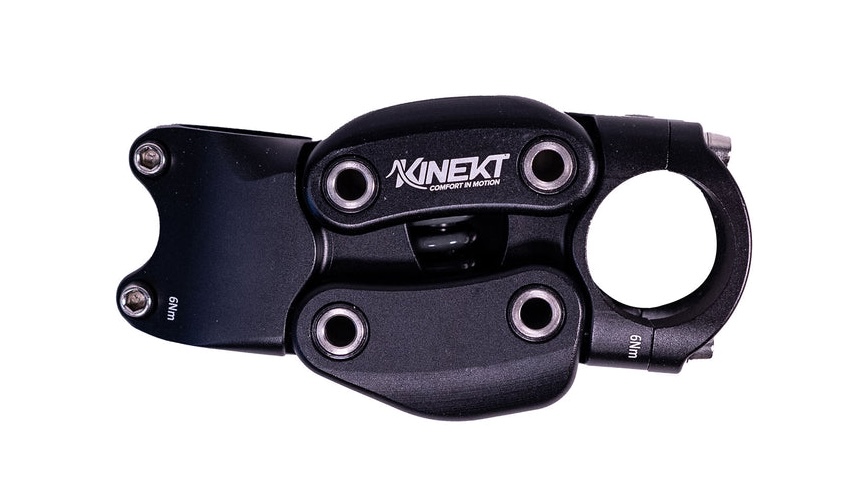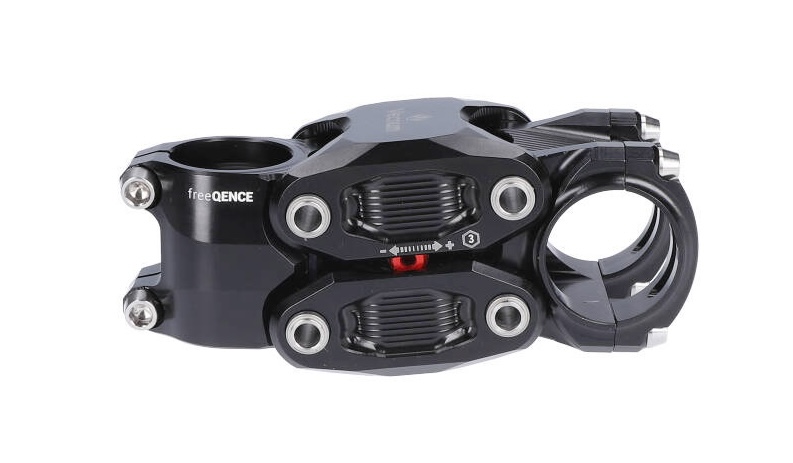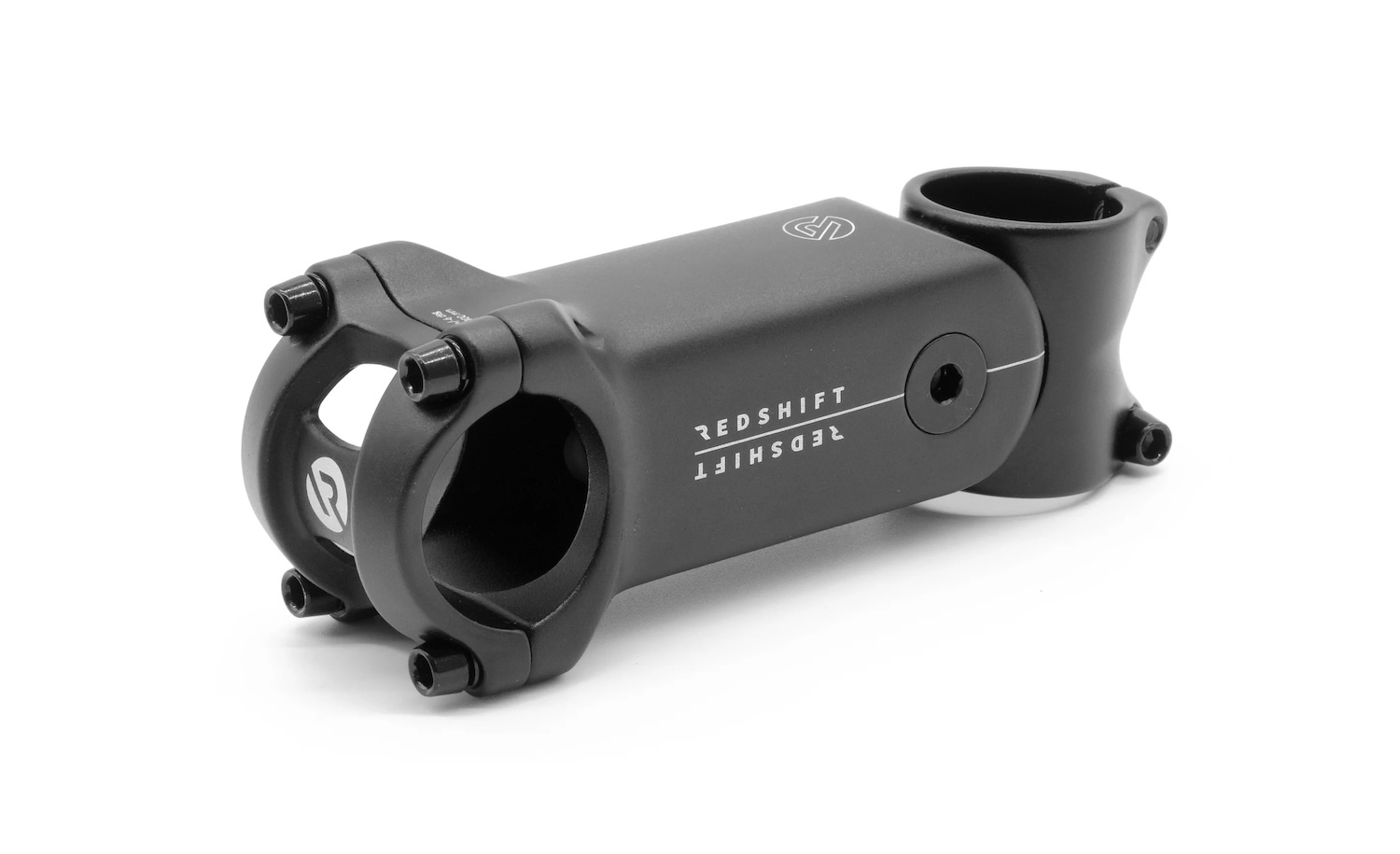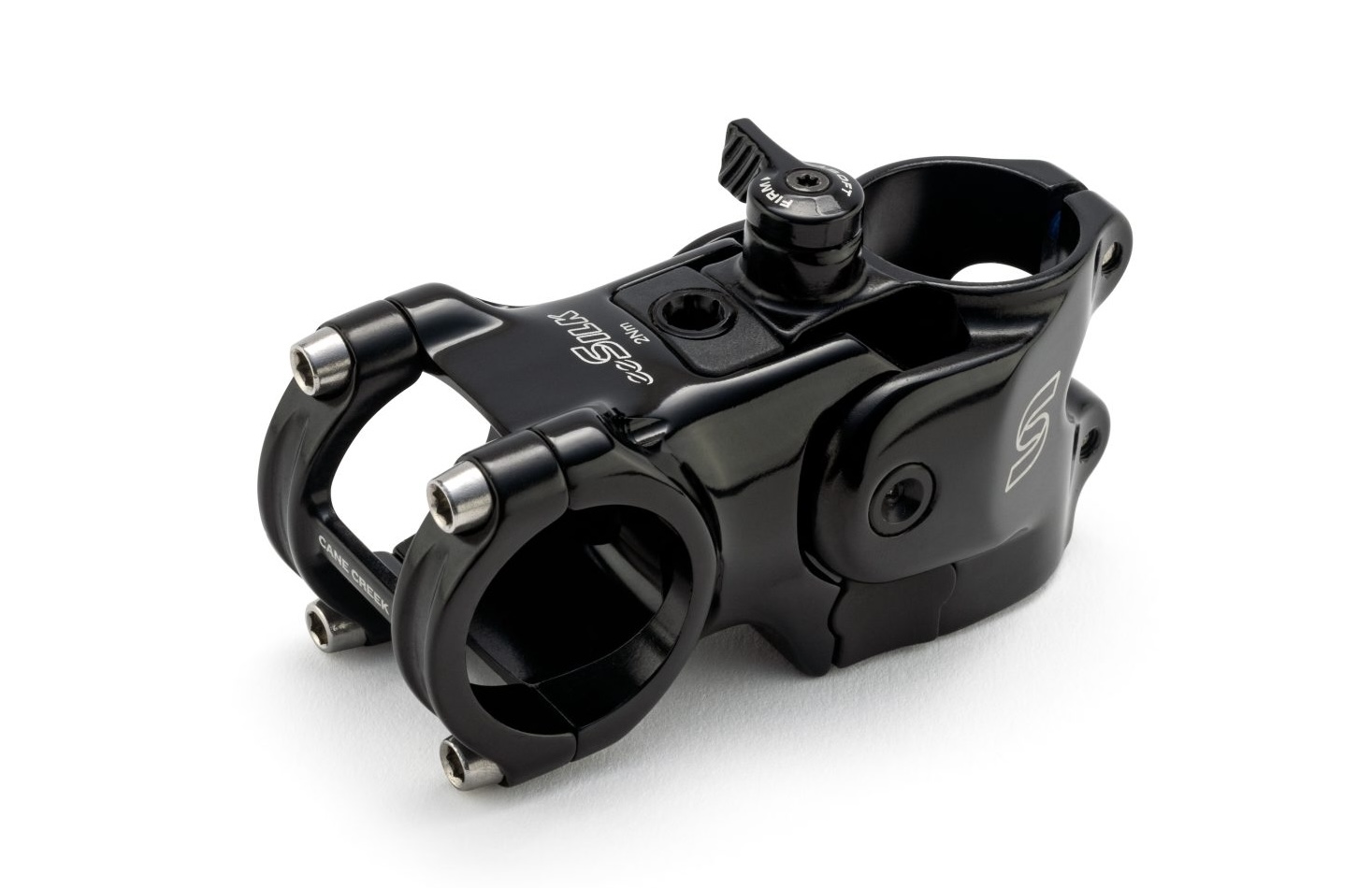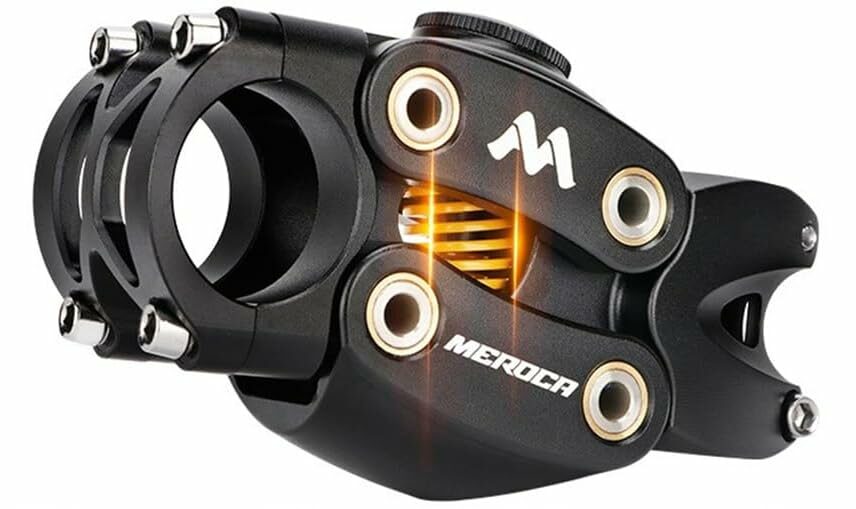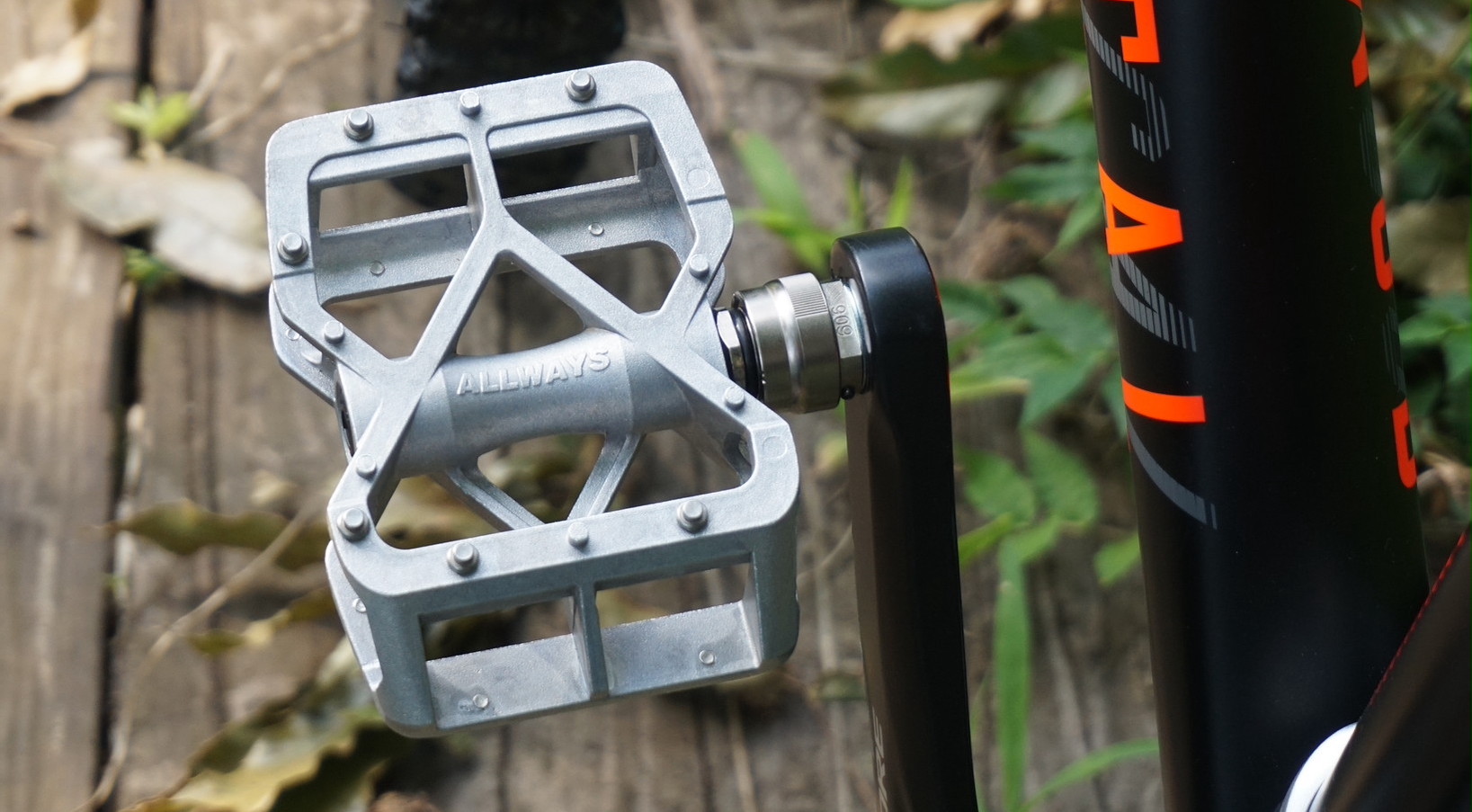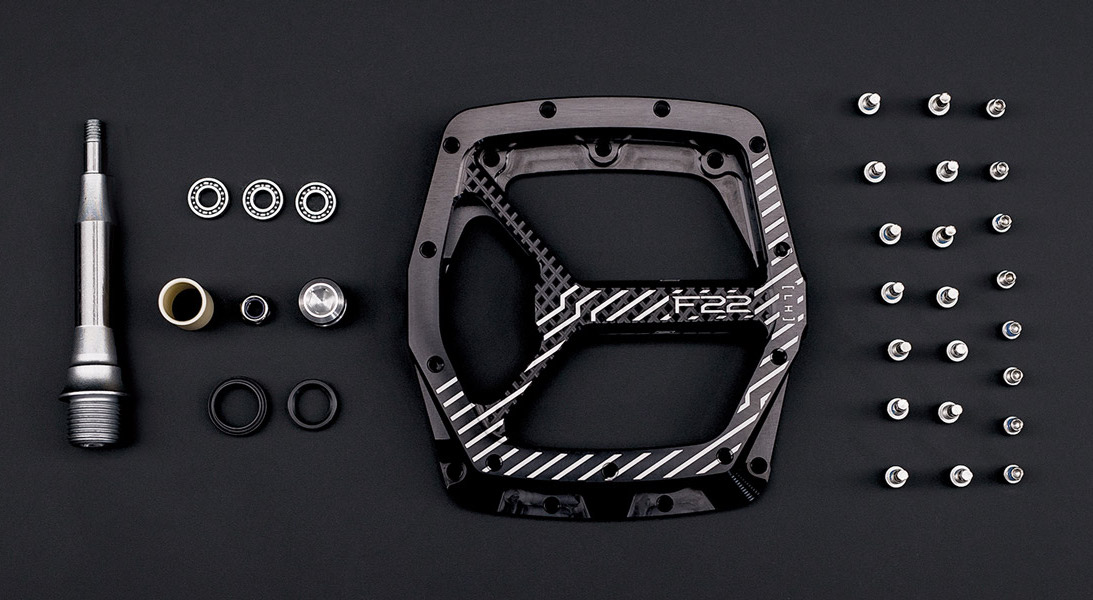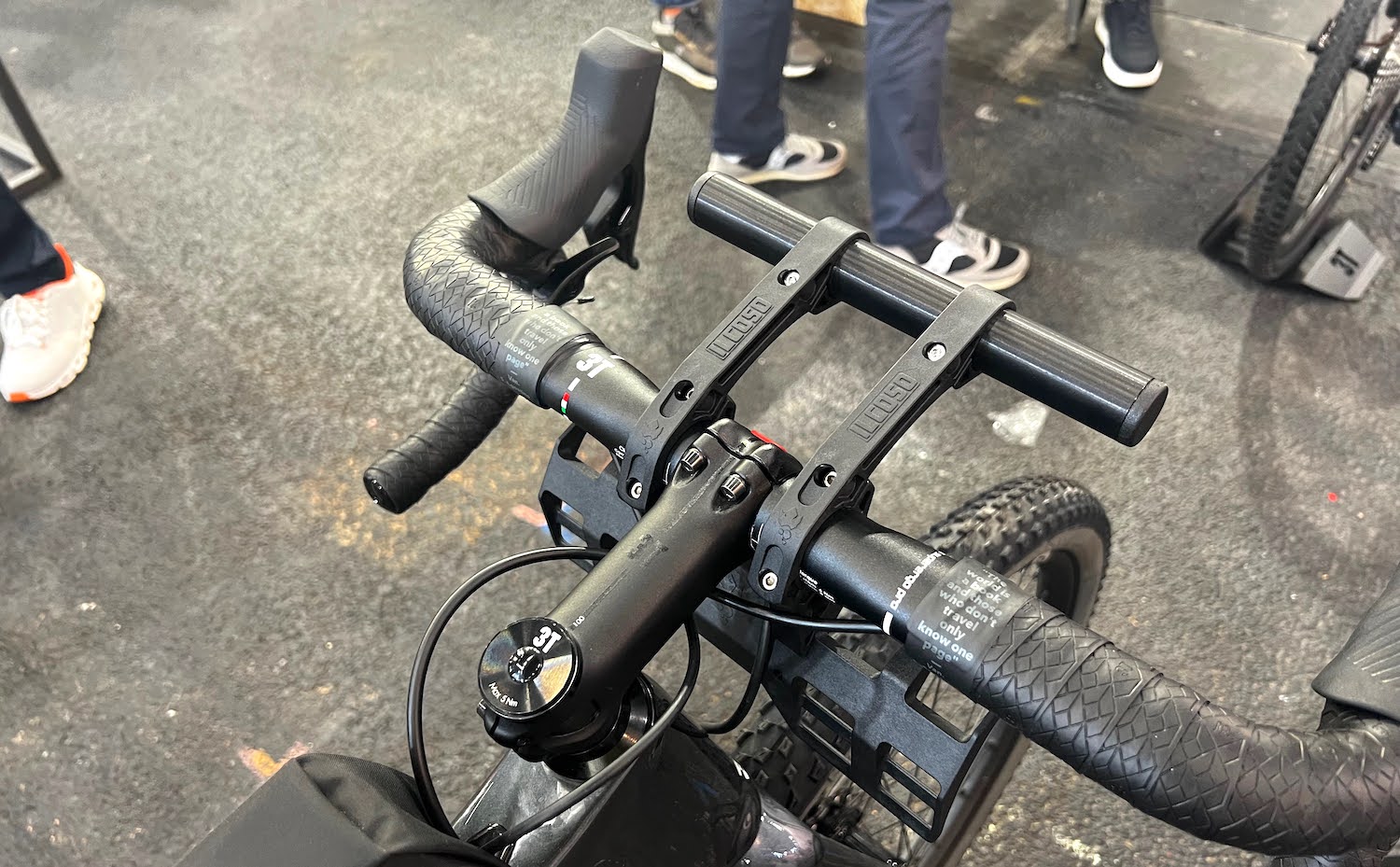Table of Contents
- Suspension Stem Advantages (Compared to Rigid Stems)
- Suspension Stem Advantages (Compared to Suspension Forks)
- Suspension Stem Disadvantages (Compared To Rigid Stems)
- Suspension Stem Disadvantages (Compared to Suspension Forks)
- Suspension Stem Designs
- Spring Types
- Best Suspension Stem #1: Kinekt
- Best Suspension Stem #2: Vecnum Freeqence
- Best Suspension Stem #3: Redshift ShockStop
- Best Suspension Stem #4: Cane Creek eeSilk
- Specialized Future Shock
- Suspension Stem FAQs
- Summary
On first impression, you might think suspension stems are just another cycling gimmick.
But vibration test data coming out of the CYCLINGABOUT Comfort Lab show that these stems are very effective at reducing the jarring impact of bumps, potholes, and rough roads.
Not only are suspension stems comfortable, but they are also lightweight, reliable, and able to be installed on almost any bike. I’ve even found these stems to be hugely beneficial on bicycles with very wide tyres.
In this article, we will examine the advantages and disadvantages of suspension stems. I will then explain the different spring and linkage designs, and finally, I’ll tell you about the best products available. I’ll be lumping the Specialized Future Shock into this article too, as it functions similarly.
Let’s start with the advantages of suspension stems when compared to rigid stems.
Suspension Stem Advantages (Compared to Rigid Stems)

Vibrations coming up from the road dissipate in your body causing fatigue. This manifests as discomfort including muscle soreness, hand numbness, and neck and shoulder pain.
A suspension stem increases your comfort by removing a significant portion of these vibrations. Our tests with an accelerometer show a vibration reduction of up to 30% over a rigid stem. Keep in mind that vibration exposure is greater on longer rides, so the more time you spend on your bike, the more comfort you have to gain.
Suspension stems also reduce the impact force on your hands. This means you don’t need to grip your bars as tight over bumps, allowing for more effortless braking and control.
These stems might even make your bike faster. This is because the stem can absorb more of a bump, minimising your upper body movement.
A great thing about suspension stems is that they can fit all bikes. You can simply remove your rigid stem, and swap one in.
Ok, let’s now look at the advantages suspension stems have over suspension forks.
Suspension Stem Advantages (Compared to Suspension Forks)
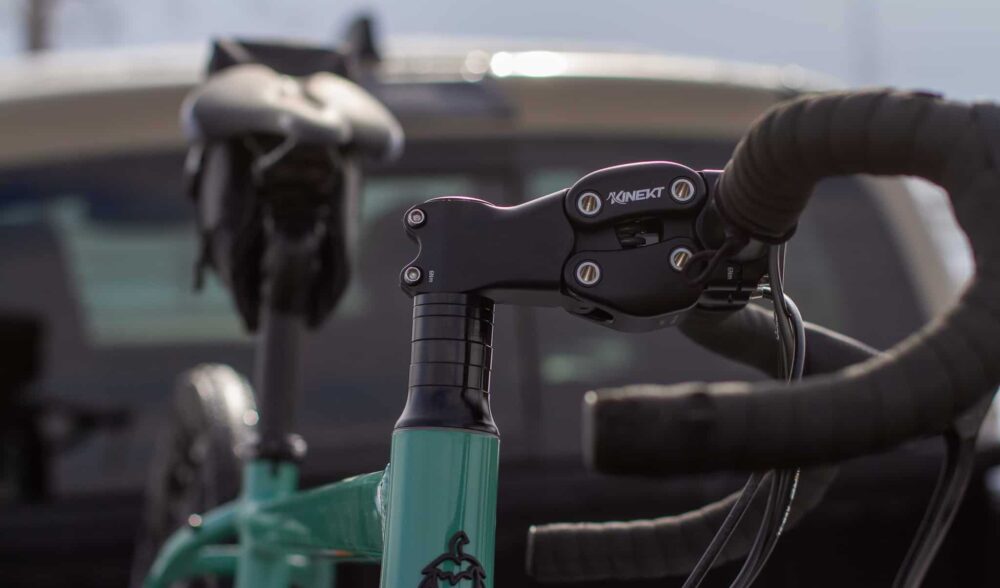
Suspension stems are often better than forks at absorbing the high-frequency vibration that you experience on fast gravel roads. This is because they require very little damping, which allows them to move virtually uninhibited over fast, repetitive bumps.
They also require virtually no maintenance, and their performance doesn’t deteriorate over time. In comparison, more complex suspension forks require regular servicing to ensure they function well.
Suspension stems are lightweight too, typically adding just 100 or 200 grams to a rigid bike, whereas a suspension fork often adds a full kilogram (2.2lb).
At US $100 to $300, suspension stems are a relatively cheap upgrade. Consider that good suspension forks start at US $400 and max out at over $1500!
There is also no measurable loss in power transfer when you accelerate. In comparison, suspension forks are stimulated on every pedal stroke, losing energy from the system.
These stems are a notably aerodynamic way to achieve suspension on a bicycle. Round suspension fork legs simply don’t slice through the air as effectively as a bladed rigid fork.
And lastly, swapping out a stem is much quicker than changing a fork. This is a useful advantage if you only need suspension on your bike very occasionally.
With the advantages all laid out, suspension stems are looking pretty great. So, what are the downsides?
Suspension Stem Disadvantages (Compared To Rigid Stems)
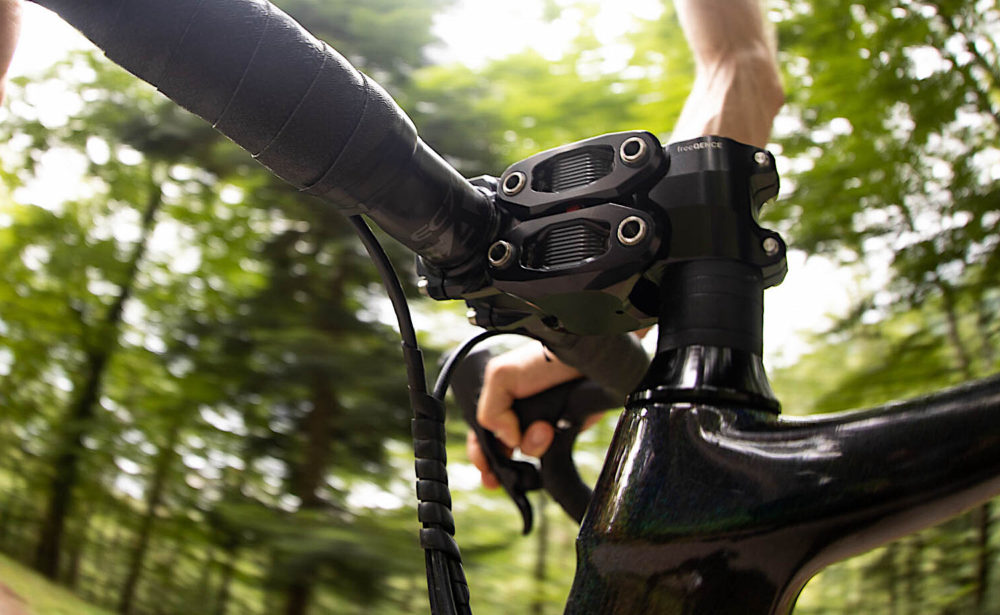
Most suspension stems bob up and down a bit while you ride. But given the 10 to 20mm range of motion, it’s not usually a big deal.
It’s worth noting that suspension stems activate much less than you’d think while sprinting, as you tend to pull up and push down on the bars at the same time.
Suspension stems are not available in super short lengths. This is a packaging issue – the pivot must be between the steerer and the handlebar. Currently, the shortest stems available are 70mm long.
And lastly, suspension stems are not exactly elegant – especially the highest-performing models. But I suspect those who are sensitive to bike aesthetics are probably not reading this article.
Let’s now discuss the disadvantages when compared to a suspension fork.
Suspension Stem Disadvantages (Compared to Suspension Forks)

Over rough terrain, a suspension stem does not offer the same level of grip or bike stability as a suspension fork.
This is because they use much less advanced dampers, they have much less tunability, and they only suspend your upper body (rather than the entire front of your bike). They also have significantly less suspension travel, which means they cannot absorb as much energy after a bigger impact.
As a result, suspension stems are simply no match when it comes to off-road performance.
Now that you understand the advantages and disadvantages of these stems, let’s get into the nitty gritty of their design.
Suspension Stem Designs
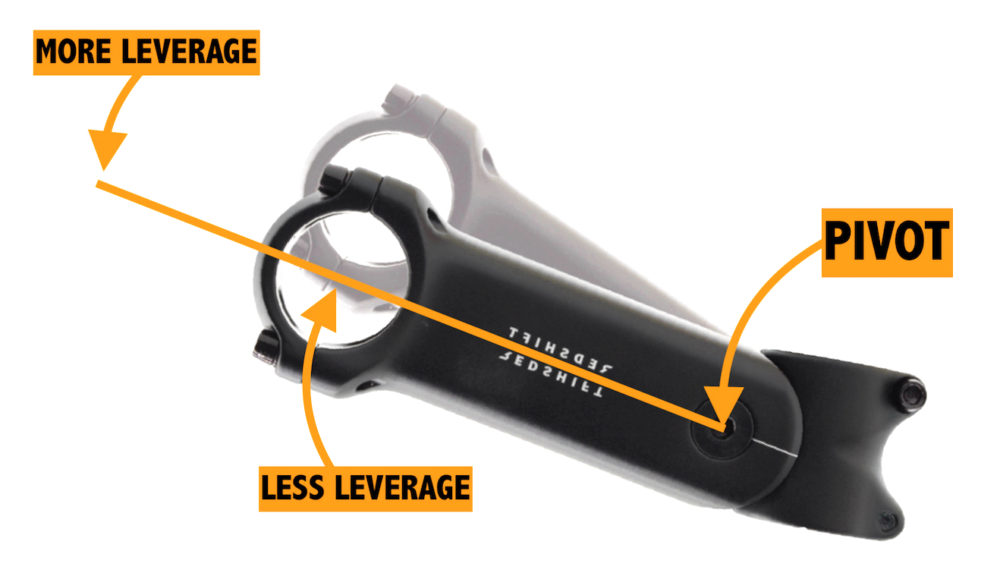
Single pivot stems are the lightest, sleekest, and most simple design. These stems offer great performance, as the internal spring is usually very responsive, resulting in great vibration damping on fast gravel roads.
There are a few downsides, however.
Firstly, the amount of leverage you apply to the spring is different depending on where you place your hands. This means that while the stem might feel supple in the brake hoods, it might be too stiff once you’ve moved to the bar tops or drops.
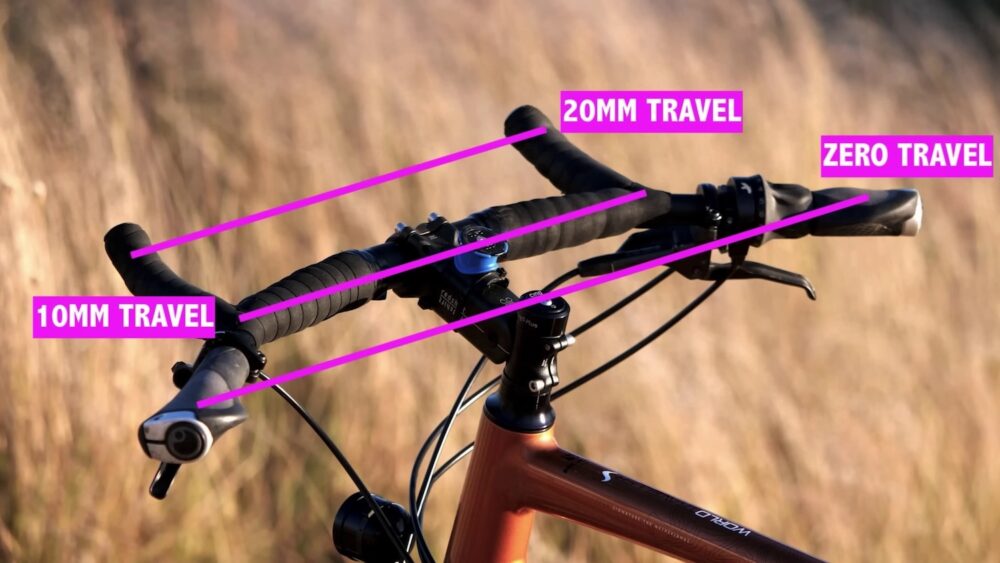
Secondly, the distance your hands are forward of the pivot point determines the suspension travel. This design quirk means that those with shorter stems miss out on some travel. It also means that single-pivot stems are best paired with drop bars, as your hands are far enough forward (at the brake hoods) to unlock the full suspension travel.
Thirdly, these stems pivot in an arc, which results in your brake and shift levers tilting forward under compression. This characteristic feels a bit strange but can be somewhat accounted for by tilting your handlebars up.
And lastly, single-pivot stems don’t accommodate sweptback handlebars well. This is because your hands simply end up too close to the pivot point.
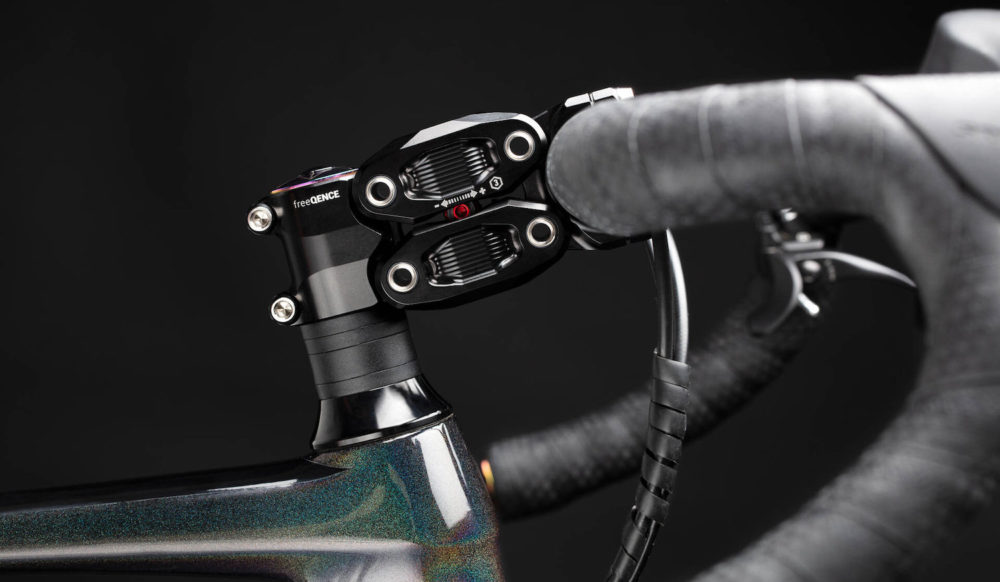
A multi-pivot stem solves most of these issues. They require the same amount of force to activate them, no matter where you place your hands. In addition, all stem lengths offer the same amount of travel, the bar angle remains consistent under compression, and they all suit sweptback bars.
The downside is that these stems have four bearings, which might develop small amounts of play long term. They also aren’t that pretty and add some weight.
Let’s now look at the two different spring types.
Spring Types
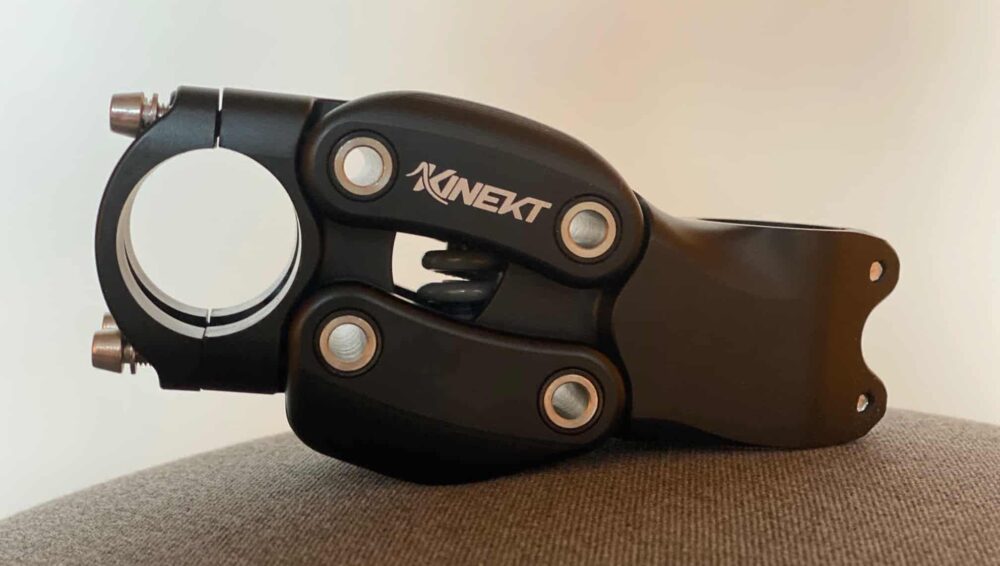
First up we have coil springs.
According to our tests, these springs consistently offer the highest level of comfort because they move up and down almost uninhibited. This very effectively smoothens out the high-frequency chatter you experience on fast gravel roads.
The downside to a very active spring is that it can feel ‘bouncy’ when you ride hard. It can also make your handlebars feel a bit disconnected from the ground below.
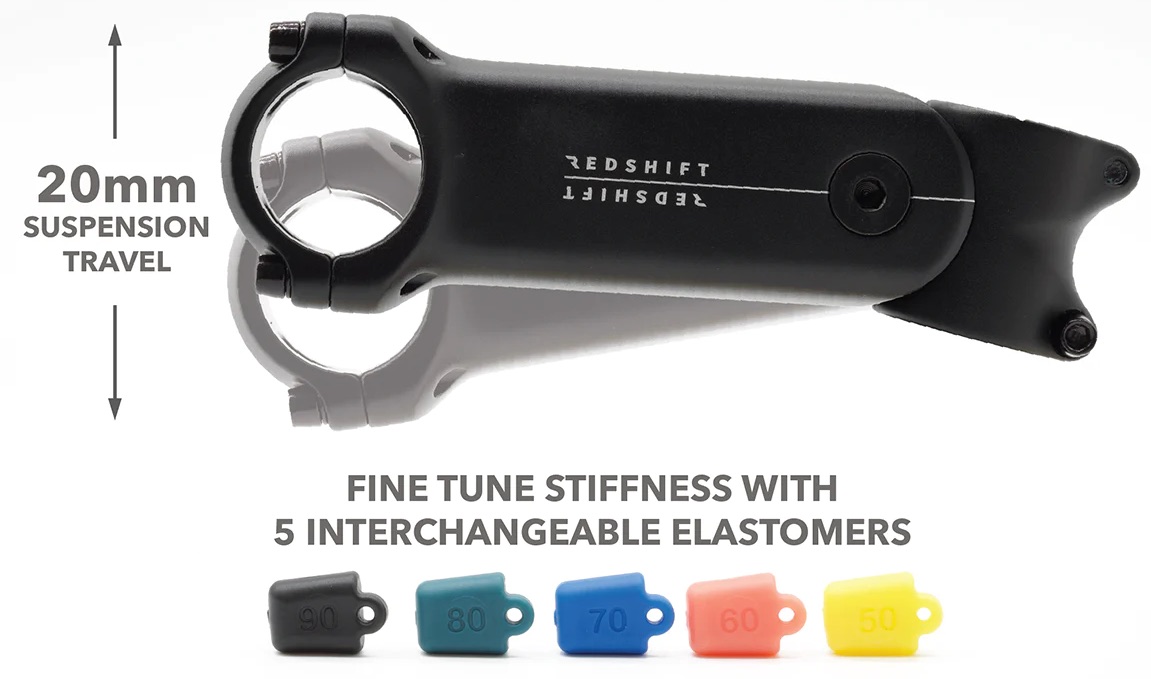
Elastomer springs are the other option.
These springs have more material damping, which not only makes them less bouncy overall but gives them a better feel. While they can’t match the high-frequency vibration damping of a coil spring, they are equally as good at absorbing bigger hits.
A downside to elastomer springs is that they can firm up in below-freezing conditions. That said, this is not considered significant until it’s ridiculously cold – Redshift says that’s at -40F/-40C.
Ok, you’re almost an expert on suspension stems now, so let’s take a close look at the best suspension stems available.
I’m going to link through to some online stores below that will give CYCLINGABOUT a small commission on any sales. If you want to support this content, this is an excellent way to do so!
Best Suspension Stem #1: Kinekt
Linkage: Multi Pivot
Spring Type: Coil
Length: 90 to 120mm
Min Weight: 470 g / 16.6 oz
Travel: 20mm / 0.8″
Bar Clamp: 31.8mm
The Kinekt suspension stem is the most comfortable model we have tested in the CyclingAbout Comfort Lab. It uses a fast-moving coil spring with 20mm of travel and employs a multi-pivot layout so that you get great performance no matter where you place your hands.
While it’s a top performer, this stem can feel a bit bouncy and vague at times. It can also make a small knocking sound after it tops out after large impacts. As a result, this stem is usually best for those with an upright riding position, or those who ride at a more relaxed pace.
The Kinekt stem comes with three spring rates to adjust to your body weight, riding style, and terrain. It’s notably stiff torsionally and is available in an array of rises and lengths, including some super-tall models for those looking for a bit more bar height.
Kinekt Suspension in 90-105-120mm with 7° angle:
$189 at Amazon
$189 at Aventuron (90mm)
$189 at Aventuron (105mm)
$189 at Aventuron (120mm)
Kinekt Suspension in 100mm with high 30° angle:
$189 at Amazon
$189 at Aventuron
$189 at REI
Kinket Stem in 100mm with very high 50° angle:
$189 at Amazon
$189 at Aventuron
Best Suspension Stem #2: Vecnum Freeqence
Linkage: Multi Pivot
Spring Type: Elastomer
Length: 90 to 120mm
Min Weight: 287 g / 10.1 oz
Travel: 20mm / 0.8″
Bar Clamp: 31.8mm
The Vecnum Freeqence is another multi-pivot stem with 20mm of travel that appears similar to the Kinekt. There are a few key differences, however.
The Freeqence uses an elastomer spring that not only has the best feel of any stem but it isn’t ever bouncy. It also has 10mm of upward travel that eliminates ‘top out’ entirely. These characteristics allow the stem to instantly fade into the background while you ride.
One of the greatest things about the Freeqence is that you can adjust the spring rate for a 50 to 120 kg rider just by using an Allen key on the side (110 to 265 lb). This is not quite an on-the-fly adjustment, but it’s close enough – no other stem provides this easy adjustability.
The Freeqence is also 40% lighter than the Kinekt stems, however, this pursuit of lightness can be to its detriment should you ride with a flat handlebar, as it has noticeably less torsional stiffness. The stem is also rather expensive due to the extensive machining and titanium axles, and I’ve found it to be less active than I’d like over fast, repetitive bumps.
Nonetheless, this stem has the least amount of compromises for my use, so this is what I’m currently using on my five-year bike journey around Africa.
Best Suspension Stem #3: Redshift ShockStop
Linkage: Single Pivot
Spring Type: Elastomer
Length: 80 to 120mm
Min Weight: 220 g / 7.8 oz
Travel: 20mm / 0.8″
Bar Clamp: 31.8mm
The Redshift elastomer stem is a proven performer, with a 20%+ reduction in vibrations compared to a regular stem. Krzysztof currently uses a Redshift as a comfort benchmark in our vibration tests.
The ShockStop is a single-pivot design, making it best suited to drop bar bikes where you can place your hands in the brake hoods.
This stem is very stiff laterally and it has a fast spring rate to damp high-frequency vibration. It’s very adjustable too; you get five different elastomers that will give you 15 different possible spring stiffnesses.
Unlike other stems, you can run the Redshift with a positive or negative rise. That said, I didn’t enjoy using the negative rise setup, as the direction of force coming from the ground is different from the stem’s movement – the stem feels best in the positive orientation.
The Redshift comes in lengths from 80 to 120mm in both 1 1/8” and 1 1/4” sizes. There’s also a high-rise version available in two lengths, and a $249 Pro version that cuts 15% from the stem weight.
Redshift ShockStop in 80-90-100-110-120mm with 6° angle:
$189 at Amazon
$189 at Angry Catfish
$189 at Competitive Cyclist
$189 at REI
Redshift ShockStop in 80-100mm with high 30° angle:
$189 at Amazon
$189 at Angry Catfish
$189 at Competitive Cyclist
$189 at REI
Redshift ShockStop Pro Lightweight in 80-90-100-110-120mm:
$249 at Amazon
$249 at Angry Catfish
$249 at Competitive Cyclist
Best Suspension Stem #4: Cane Creek eeSilk
Linkage: Single Pivot
Spring Type: Elastomer
Length: 70 to 100mm
Min Weight: 225 g / 7.9 oz
Travel: 20mm / 0.8″
Bar Clamp: 31.8mm
Cane Creek offers a single-pivot elastomer stem that’s very similar to the Redshift, but this one comes with a soft-to-firm switch!
When it’s rough, run it unlocked, and when it’s smooth – stiffen it up. You can run a softer spring rate than usual as you don’t need to compromise for all riding situations.
If you prefer a cleaner look, the Cane Creek is also available without the lockout switch. Both models are available in 70, 80, 90, or 100mm lengths.
Cane Creek makes it easy to change between the three spring rates. You don’t need to remove the handlebar like you do with the Redshift stem – undoing just one bolt allows you to swap in a softer or firmer elastomer.
Unfortunately, the Cane Creek can only be used in the negative orientation, which again, is not optimal as the stem moves in a different direction from the forces coming up from the ground.
Cane Creek eeSilk in 70-80-90-100mm lengths with switch:
$229 at Angry Catfish
$229 at Backcountry
$229 at Competitive Cyclist
$229 at REI
Cane Creek eeSilk in 70-80-90-100mm lengths:
$199 at Backcountry
$199 at Competitive Cyclist
Specialized Future Shock
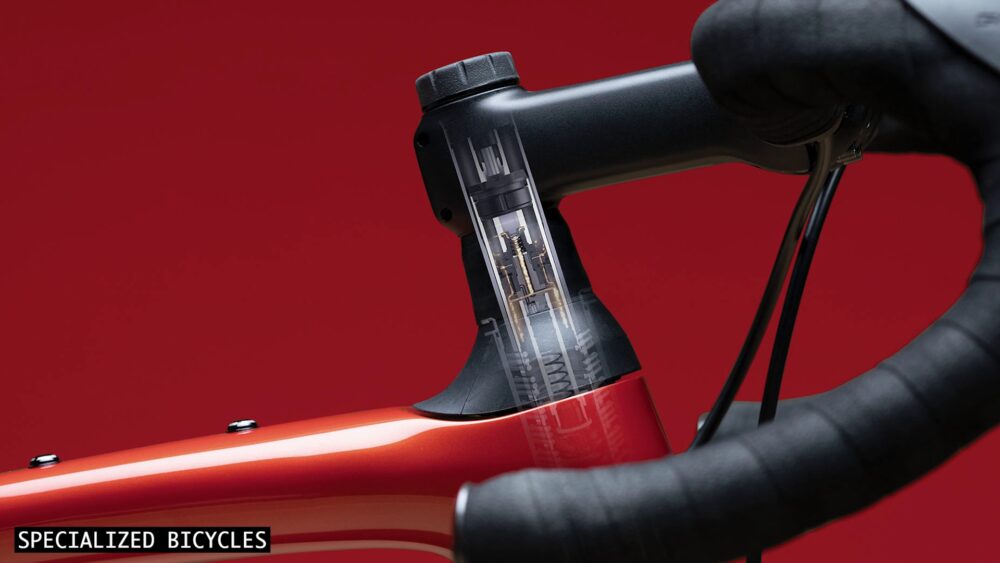
The last product I want to show you is the Future Shock, which is only available on Specialized gravel and endurance road bikes.
This 20mm travel suspension element uses a sensitive coil spring just like the Kinekt stem, but it additionally has a hydraulic cartridge damper inside to control the spring speed. This product not only feels great, but it has a compression dial that allows you to quickly adjust the firmness from completely open to locked out.
The reason why I wanted to include the Future Shock in this article is that it offers the most gravel road comfort of any front suspension products we’ve tested, and that includes suspension forks too.

On a bumpy forest trail, we found the Future Shock could attenuate 6% more vibration than a bike fitted with both a Lauf suspension fork AND a Redshift suspension stem. On a fast gravel road, the Future Shock absorbed almost 20% more vibrations! This is an amazing result given we already know the Redshift stem is leaps and bounds more comfortable than a rigid stem.
We’ve so far found the Future Shock to be the holy grail in terms of performance, adjustability, lock-out, and aesthetics. A bonus is that it can even fit stems shorter than 70mm.
But the downside to this high-tech solution is that it’s only available on some Specialized bikes, and the complexity results in more servicing requirements, potential points of failure, and in the future, the inability to obtain spare parts.
Let’s finish up with a few quick frequently asked questions.
Suspension Stem FAQs

Can you combine suspension forks and suspension stems?
Suspension stems deflect just 10 to 20mm, so this movement will have a minimal effect on the handling of your bike. If you want better vibration damping on a fast gravel road, or you feel the need for a small boost in suspension travel, a suspension stem would do that for you.
Can you use front luggage with suspension stems?
You can use a front bag with a suspension stem but you will need to compensate by using a stiffer spring.
Do suspension stems work on a quill stem bike?
Yes, you can fit them with an adapter.
Are there any stems under $100?
Linkage: Multi Pivot
Spring Type: Coil
Length: 90mm
Min Weight: 485 g / 17.1 oz
Travel: 20mm / 0.8″
Bar Clamp: 31.8mm
You can find generic coil-spring, multi-pivot stems sold under many names including Meroca, Bibike, and JFOYH.
These stems are not the best choice if you’re planning on riding hard, as they tend to top and bottom out on rough terrain, making a clunking sound. But if your riding position is upright and your riding style is relaxed, they should offer decent performance – especially for the price.
Just note that there is a single length available with these stems (90mm).
The TranzX Antishock is another cheap stem. However, this model has been lab-tested to be ineffective, so it’s best to skip it.
Summary
I originally expected suspension stems to be a gimmick, but ultimately, I’ve found them to increase the fun and enjoyment of cycling by way of a comfort boost – and you will appreciate that on longer rides. As a result, I can only recommend you try one.
There are trade-offs to coil and elastomer springs, as well as single-pivot and multi-pivot stem designs. Make sure to carefully examine the pros and cons of each design to find the product that best suits your needs.


